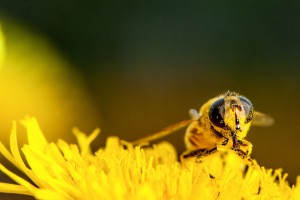What’s the Buzz about Dying Bees?

Seven species of wild bees indigenous to Hawai’i have officially been classified as endangered species by the US Fish and Wildlife Service. This means that they are protected by the Endangered Species Act, which requires federal agencies to ensure that their actions do not threaten the conservation of the bees’ habitat. These “yellow-faced” wild bees of the genus Hylaeus are credited with pollinating the majority of Hawai’i’s major plant life, including threatened plant species.
Conservationists consider this classification a victory, as these particular bees are the first bees to be categorized as endangered species. This categorization follows the US Fish and Wildlife Service’s petition proposing that the rusty-patched bumble bee, endemic to North America, be listed as an endangered species. The rusty-patched bumble bee population has declined 90 percent since 1990 due to pesticides, mites and other pests, diseases, and destruction of its natural habitat.
In fact, bee populations of all species have been of concern since 2006, when the winter’s seasonal die-off of domesticated honeybees was much higher than usual. Named by researchers as the Colony Collapse Disorder, this bizarre phenomenon involves the disappearance of all worker bees from a hive, leaving only the queen and a few drone bees. Their disappearance results in alarmingly high rates of colony loss in the wintertime. Beekeepers report that it’s sustainable and expected to lose about 16.9 percent of their bees in the winter time, although they’ve been losing 35-45 percent of their colonies in the past couple of years. This increased loss is possibly due to a combination of factors, including climate change and the use of a class of pesticide called neonicotinoids, which are highly toxic to bees.
Domesticated honeybees in the US are worth about two billion dollars, and their decline has been alarming enough to spur the White House’s 2015 publication of the “National Strategy to Promote the Health of Honey Bees and Other Pollinators,” which estimates their contribution of value to food crops through pollination at fifteen billion dollars. Honeybees pollinate 75 percent of the produce we eat.
Some economists and analysts like Christopher Ingraham at the Washington Post’s Wonkblog suggest that beekeepers and their industry are what’s really dying out because of the increasing financial burdens of maintaining bee colonies—not the dying-off of honeybees. However, the fact that wild bee populations are also declining suggests that we should take the decreasing number of bees seriously for their environmental impacts across so many ecosystems—including our own. In light of the addition of these seven species of bees to the endangered species list, Ingraham has updated his Washington Post article but still dismisses these species as “obscure” and continues to argue that domesticated honeybees are thriving. Yet, if the cost of maintaining honeybee populations increases, thus reducing the number of beekeepers who can afford to stay in business, won’t the rate of replenishing domestic honeybees also decrease?
In addition to their benefits to our ecosystem and produce, bees are fascinating creatures that have provided us with insight on swarm behavior, swarm intelligence, decentralized systems, and, more recently, on the spread of culture.
Regardless of their economic value or how observing their behaviors have contributed to our increased knowledge, humanists have a responsibility to care about bees’ existence simply because we ought to consider ourselves as stewards of our planet and its organisms. Otherwise, who else would?
